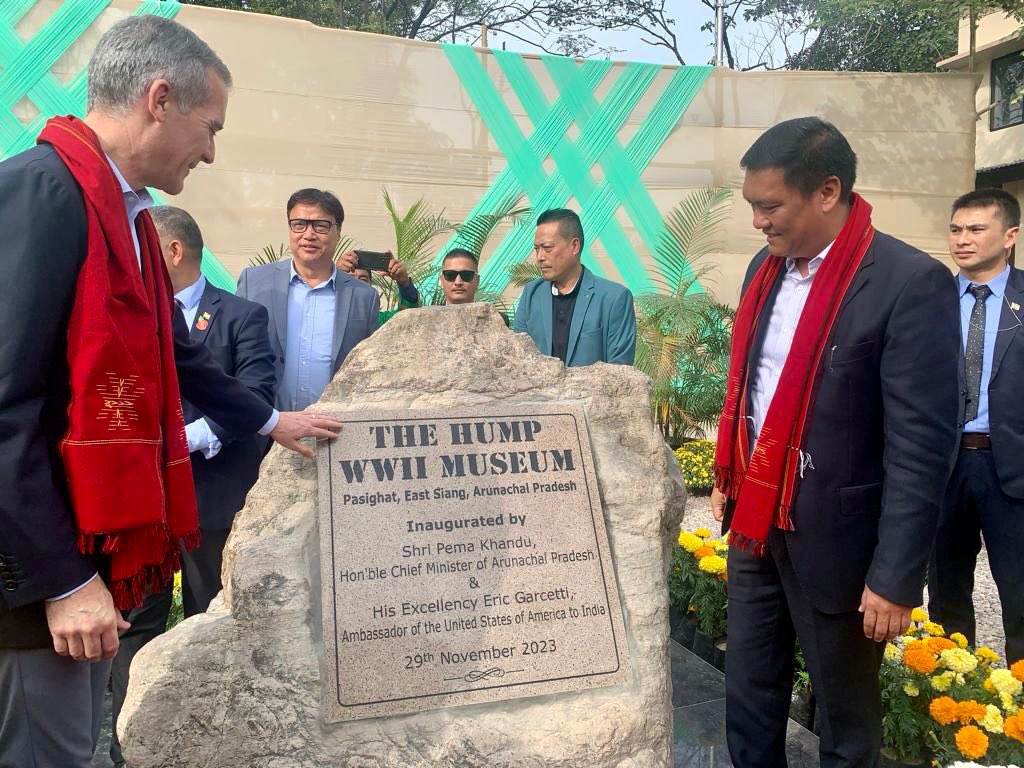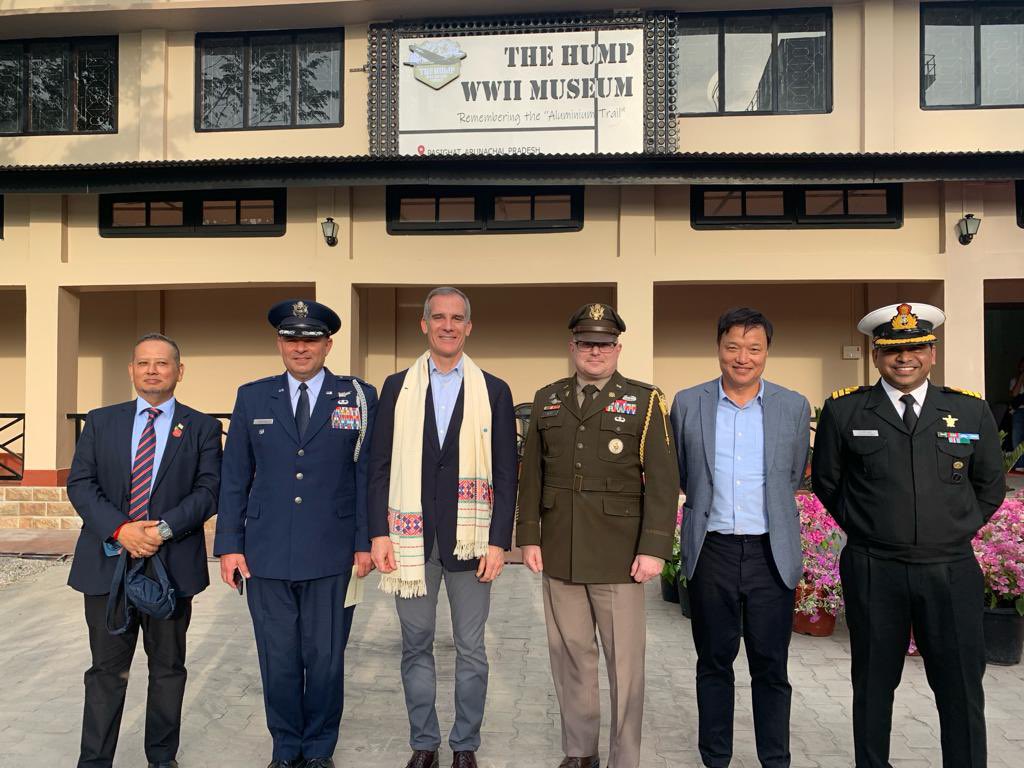On September 15, airmen from the US Air Force’s 25th Fighter Squadron, also known as the “Assam Draggins,” visited the Hump World War II Museum in Pasighat, Arunachal Pradesh, India, to pay homage to the brave airmen who lost their lives during World War II.
The visit served as a poignant reminder of the squadron’s legacy and the risky missions flown over the notorious “Hump” route during the war.
The Hump World War II Museum, inaugurated in November 2023 by Arunachal Pradesh Chief Minister Pema Khandu and US Ambassador Eric Garcetti, is a testament to the sacrifices made by the US airmen who flew the route.
The museum features artifacts from the war, including 80-year-old wreckage, machine guns, and other relics from the 590 Allied planes, primarily American, that crashed in the region.
During their visit, Lt.Col. Justin “Riot” Davis and Capt. Nivruth Maramreddy of the 25th Fighter Squadron expressed deep emotion as they honored the fallen heroes.
AfriPrime App link: FREE to download...
https://www.amazon.com/Africircle-AfriPrime/dp/B0D2M3F2JT
“We are very delighted and emotionally touched by visiting this beautiful museum, ‘The Hump‘ and paying homage to our fellow airmen from 25th Fighter Squadron ‘Assam Draggins‘ who lost their lives while flying for the allied forces from Assam to Yunnan province of China via mountainous regions of Arunachal Pradesh,” the officials added.
The squadron’s first combat mission over the Hump took place on September 25, 1942. After relocating to Dinjan, Assam, the 25th Fighter Squadron intensified its combat activities, earning the nickname “Assam Draggins” due to their relentless efforts in the region.
The Hump route remains infamous for the danger it posed. The treacherous combination of high-altitude flying, turbulent weather, and difficult terrain claimed the lives of hundreds of airmen, with approximately 400 still missing in the region.
Since 2009, joint Indian and American teams have been trekking through the rugged mountains of Arunachal Pradesh in northeastern India, searching for the remains of aircrews and wreckage from hundreds of planes that vanished during World War II.
These aircraft crashed in the region’s unforgiving terrain, with recovery efforts hampered by the dense forests and challenging conditions. The mission is part of a long-standing effort to bring closure to the families of those who disappeared in one of history’s most dangerous air routes.

In 2016-17, the US Defense Prisoner of War/Missing in Action Accounting Agency (DPAA) deployed teams to Arunachal Pradesh for search missions to locate the remains of these unaccounted-for airmen.
John Tayeng of Abor Country Travels & Expedition, who helped coordinate the visit, described it as an “honor” to welcome the 25th Fighter Squadron back to the region after 81 years.
Their visit not only pays tribute to their fallen comrades but also highlights the historical significance of the Hump route and the sacrifices made by those who flew along it.
Operations Over “The Hump”
During the World War II, the US Air Force’s 25th Fighter Squadron played a critical role in Allied operations, flying numerous combat missions over the treacherous Hump route between Assam and Yunnan, China.
This hazardous air passage, which passed over the towering Himalayas and rugged terrain of Assam, Arunachal Pradesh, Tibet, Myanmar, and China, was used to transport essential supplies such as fuel, food, and ammunition to support the Allied forces fighting in China.
AfriPrime App link: FREE to download...
https://www.amazon.com/Africircle-AfriPrime/dp/B0D2M3F2JT
The squadron’s missions, which began in 1942, transported nearly 650,000 tonnes of vital supplies despite the numerous challenges posed by the harsh weather and mountainous geography.
Tragically, approximately 600 aircraft crashed during these operations, making the Hump one of the deadliest air routes in the history of aviation.
The history of the 25th Fighter Squadron began before its involvement in the Hump operations. Originally known as the 25th Pursuit Squadron, it was activated at Hamilton Field, California, on January 15, 1941. Initially, the squadron was assigned to the 51st Pursuit Group at March Field, California, where it received P-40 aircraft in July 1941.
With the outbreak of war following the attack on Pearl Harbor, the squadron embarked on its first deployment overseas. On January 11, 1942, the 25th Pursuit Squadron sailed aboard the S.S. President Coolidge, marking one of the first US forces to leave the mainland after the official declaration of war against Japan.
Their journey took them to Melbourne, Australia, where they arrived 20 days later. By late March 1942, the squadron had reached Karachi and set up operations to begin their involvement in the war effort in Asia.
As stated above, on September 25, 1942, the 25th Fighter Squadron flew its first combat mission over the Hump, escorting aircraft over the treacherous terrain.
The squadron’s relocation to Dinjan, Assam, in India, further increased its combat operations. During this period, the squadron earned the nickname “Assam Draggins,” derived from its relentless efforts in the region.
The squadron’s combat operations primarily focused on battling Japanese forces in northern Burma, particularly along the Chindwinn and Irrawaddy Rivers.
The first major moment of recognition for the squadron came in February 1943, during its mission to defend Fort Hertz near Myikina. This fort was a crucial airbase for operations along the Hump. For 12 consecutive days, the 25th bombed and strafed Japanese troops, supply depots, bridges, and communication lines.
Despite these efforts, they were unable to slow the enemy’s advance. Heavy bombers were required to halt the offensive, but none were available at the time.
However, Lt. Col. John E. Barr, the executive officer of the 51st Fighter Group, modified a P-40 aircraft to carry 1,000-pound bombs, and by May 1943, the squadron had successfully repelled the Japanese advance.
Throughout the war, the 25th Fighter Squadron saw more combat activity than any other unit within the 51st Fighter Group. The squadron’s operations were vital in disrupting Japanese supply lines and supporting Allied ground troops.
After the war, the squadron returned to the United States and was officially inactivated on December 12, 1945. But, this deactivation was short-lived.
On October 15, 1945, the 25th Fighter Squadron was reactivated at Naha, Okinawa. Now equipped with P-47 and F-80 aircraft, the squadron was tasked with providing defense for the Ryukyu Islands as part of the occupation forces.
The squadron’s involvement continued during the Korean War when it transitioned to flying F-86 Sabre jets. On November 20, 1951, the squadron received its new F-86s and quickly faced off against communist pilots flying MiG-15s in what marked the beginning of a new era of jet air-to-air combat.
During the Korean War, the 25th Fighter Squadron adopted the “Checkertails” designation, inspired by the checkered markings on the tails of its F-86s. This new identity carried over from its previous reputation as the “Assam Draggins” of World War II.
Following the Korean War, the 25th Fighter Squadron was stationed at Naha Air Base, Okinawa, Japan, with pilots rotating weekly to Kadena Air Base.
From 1960 to 1965, the squadron had minimal activity and staffing. On June 17, 1965, it was re-designated as the 25th Tactical Fighter Squadron and assigned to Eglin AFB, Florida.
In 1968, the squadron was deployed to Ubon and Udorn Royal Thai Air Force Bases during the Vietnam War, flying F-4 aircraft. During this period, the unit received several honors, including the Presidential Unit Citation and the Republic of Vietnam Gallantry Cross.
After the US withdrew from Thailand, the 25th TFS returned to Kadena AB before being relocated to Suwon Air Base, South Korea, in 1981.
In 1982, the squadron received A-10 Thunderbolt II aircraft, which contributed to maintaining peace on the Korean Peninsula until its inactivation in 1990.
Re-activated in 1993 at Osan AB, the squadron became dual-qualified with A/OA-10 aircraft and remains the only A-10C unit within the Pacific Air Forces specializing in close air support on the Korean Peninsula.
AfriPrime App link: FREE to download...





